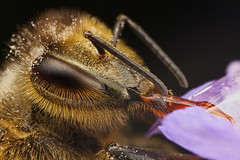I’ve been putting a little money aside for a while so I could pick up some new gear. Photography isn’t what I do for a living and with a wife and three kids I just can’t spend money on stuff that doesn’t help pay for the important things like electricity and food. But I managed to get in range of the Canon 180mm L macro and thought about finally getting it…
Over the course of this past weekend I talked myself out of spending the money –the 180L just won’t allow me to do anything that I’m not currently doing with the glass that I have and I don’t need the extra reach. In fact putting more distance between me and the subject could actually be detrimental. Take the shot I’ve included with this post, shot at three times life size with a Canon MPE-65mm lens. The only way I could get a sharp image of that honeybee was to hold on to the flower that it was feeding on. So with the flower’s stem pinched between my left index finger and thumb I rested the lens on my left hand and adjusted the focus by sliding the lens back and forth. Since the lens and the subject were on the same platform, my hand, I could keep the scene rock solid and take full control over where I placed the depth of field. Now imagine that same shot with a 180mm lens and two teleconverters (a 1.4x and a 2x) for 2.8x at a nine inch working distance.
I’d have to rest that bazooka of a lens on my forearm and try to shoot over the ridge of my thumb…
It’s not possible to take a shot of an insect on a flower without holding on to the stem –the slightest breeze is enough to throw the critter out of the plane of sharp focus. The best way to get a sharp, well composed image is to take full control of the scene and I just can’t do that by standing back with a long focal length lens. The 180L will have to wait for another day…


6 comments:
I agree. A greater working distance would also mean that the flash would too be at a greater distance, meaning more power (longer recharge time) and less evenly distributed light, even if you managed to get the focus... Right?
Stavros
PS. I'm in a similar situation here:
wife + 2 kids + mortgage = no new gear for me :-(
Hey Stavros!
There are two flash related problems with longer lenses: longer flash durations (as you mentioned) means that it's more difficult to freeze motion. The second is that you have to use a larger diffuser to get light that isn't harsh. So you have to get the flash close to the subject anyway, and there goes the working distance advantage...
I take 2 kinds of macro images, those with my MPE-65 at close range, fully lit by flash, which are 1:1 or greater and those with my Sigma 150 which tend to be of much larger whole insects, especially butterflies and dragonflies, in natural light (and maybe a bit of fill-flash). In the latter type of photography a bit of working distance makes life much easier. But I wouldn't be without either lens and very much enjoy both types of macro photography.
So you would find that you would take very different images with the 180 and probably of different subjects. I tend to ignore small insects such as hoverflies and bees when I'm shooting with my Sigma but can't leave them alone when I'm using the MPE-65 :-)
Matt
@ Matt: This post is geared toward shooting macro -at least life size magnification. When shooting close-ups I think that more working distance is better simply because I want to be far enough away to keep the critter comfortable. But I've taken a lot of those same images with a 100mm macro lens + a 500D close-up filter at magnifications that put me no more than 12" from the subject...
Like you I wouldn't bother shooting a hoverfly at life size -but won't hesitate to try to grab the stem of the flower it's on so I can get a rock solid 3x shot...
HI Dalantech:
Iam a very fan of your work, very very.
Iam from Argentina and here , i Dont know nobody, who shots macros with you r quality.
I admire your sharing concepts and investigations about this "art", MACRO ART, of course.
I have many doubts, i dont know if this is the place to put some, but well if its not, just tell me.
The first one, could be...
I have a recently adquisition, a 40 d and mpe 65 and mt 24 ex, like your stuff.
Iam trying taking shots like a sunny 16 rule and have a good results, but so far away with your details in a critters...
can I shut with a speed like a 1/100 second a f:16 and a flash in ettl?, what do you think?
After reading a strobist ( greater lighting theory), i like to try to light background with a second slave flash( a 430 ), what do you think...
Well I have a lot o doubts, but, I think , that is enough for today...
Sorry, and thankS! a lot!
The best advice I can give you is to experiment! If you want to trade a stop in shutter speed for more depth (by going to F16) then give it a try. You wouldn't believe how much I play with different settings and how much testing I do out in the field...
Post a Comment